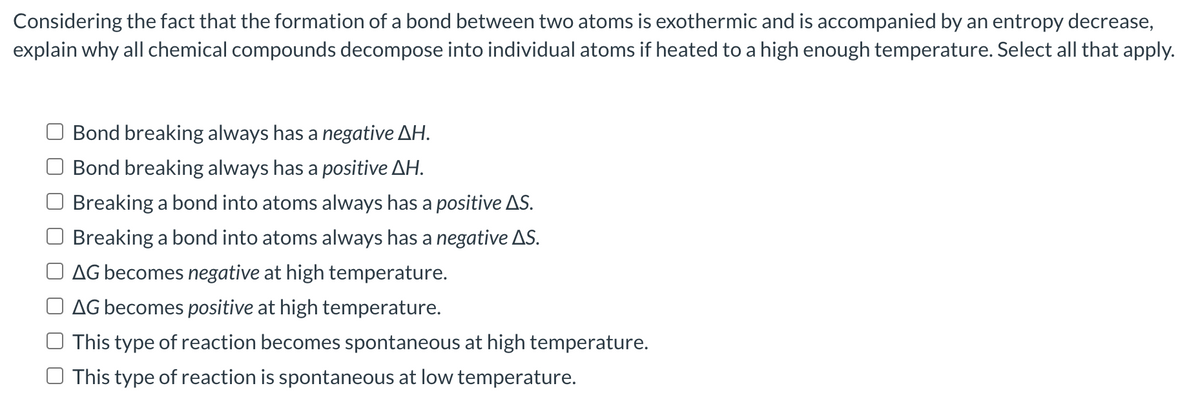Considering the fact that the formation of a bond between two atoms is exothermic and is accompanied by an entropy decrease, explain why all chemical compounds decompose into individual atoms if heated to a high enough temperature. Select all that apply. Bond breaking always has a negative ΔΗ. Ο Bond breaking always has a positive ΔΗ. Breaking a bond into atoms always has a positive AS. Breaking a bond into atoms always has a negative AS. AG becomes negative at high temperature. O AG becomes positive at high temperature. This type of reaction becomes spontaneous at high temperature. This type of reaction is spontaneous at low temperature.
Considering the fact that the formation of a bond between two atoms is exothermic and is accompanied by an entropy decrease, explain why all chemical compounds decompose into individual atoms if heated to a high enough temperature. Select all that apply. Bond breaking always has a negative ΔΗ. Ο Bond breaking always has a positive ΔΗ. Breaking a bond into atoms always has a positive AS. Breaking a bond into atoms always has a negative AS. AG becomes negative at high temperature. O AG becomes positive at high temperature. This type of reaction becomes spontaneous at high temperature. This type of reaction is spontaneous at low temperature.
Chemistry: The Molecular Science
5th Edition
ISBN:9781285199047
Author:John W. Moore, Conrad L. Stanitski
Publisher:John W. Moore, Conrad L. Stanitski
Chapter16: Thermodynamics: Directionality Of Chemical Reactions
Section: Chapter Questions
Problem 24QRT
Related questions
Question

Transcribed Image Text:Considering the fact that the formation of a bond between two atoms is exothermic and is accompanied by an entropy decrease,
explain why all chemical compounds decompose into individual atoms if heated to a high enough temperature. Select all that apply.
Bond breaking always has a negative AH.
Bond breaking always has a positive ΔΗ.
Breaking a bond into atoms always has a positive AS.
Breaking a bond into atoms always has a negative AS.
AG becomes negative at high temperature.
AG becomes positive at high temperature.
This type of reaction becomes spontaneous at high temperature.
This type of reaction is spontaneous at low temperature.
Expert Solution
This question has been solved!
Explore an expertly crafted, step-by-step solution for a thorough understanding of key concepts.
This is a popular solution!
Trending now
This is a popular solution!
Step by step
Solved in 3 steps

Knowledge Booster
Learn more about
Need a deep-dive on the concept behind this application? Look no further. Learn more about this topic, chemistry and related others by exploring similar questions and additional content below.Recommended textbooks for you

Chemistry: The Molecular Science
Chemistry
ISBN:
9781285199047
Author:
John W. Moore, Conrad L. Stanitski
Publisher:
Cengage Learning

Chemistry for Engineering Students
Chemistry
ISBN:
9781337398909
Author:
Lawrence S. Brown, Tom Holme
Publisher:
Cengage Learning

Chemistry & Chemical Reactivity
Chemistry
ISBN:
9781133949640
Author:
John C. Kotz, Paul M. Treichel, John Townsend, David Treichel
Publisher:
Cengage Learning

Chemistry: The Molecular Science
Chemistry
ISBN:
9781285199047
Author:
John W. Moore, Conrad L. Stanitski
Publisher:
Cengage Learning

Chemistry for Engineering Students
Chemistry
ISBN:
9781337398909
Author:
Lawrence S. Brown, Tom Holme
Publisher:
Cengage Learning

Chemistry & Chemical Reactivity
Chemistry
ISBN:
9781133949640
Author:
John C. Kotz, Paul M. Treichel, John Townsend, David Treichel
Publisher:
Cengage Learning

Chemistry & Chemical Reactivity
Chemistry
ISBN:
9781337399074
Author:
John C. Kotz, Paul M. Treichel, John Townsend, David Treichel
Publisher:
Cengage Learning

Chemistry: Principles and Practice
Chemistry
ISBN:
9780534420123
Author:
Daniel L. Reger, Scott R. Goode, David W. Ball, Edward Mercer
Publisher:
Cengage Learning
